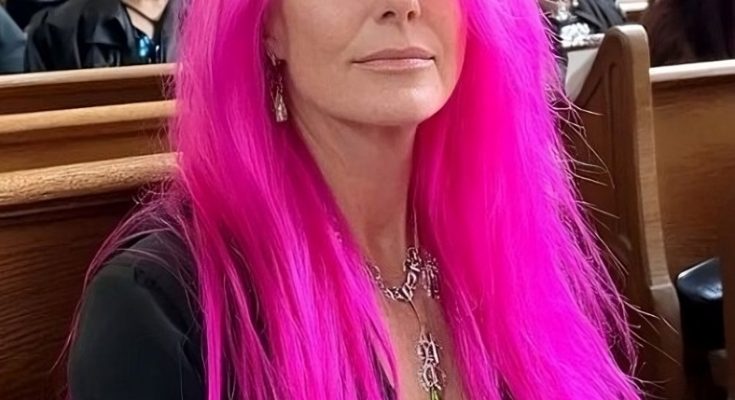Last Sunday, I experienced something that left me puzzled during a church service. While the day started off as any ordinary Sunday, it quickly took a surprising turn. I noticed a woman with bright pink hair seated near the front, and I found myself distracted. I couldn’t help but wonder: is such a bold display of self-expression appropriate for a place of worship?

Why Do Certain Appearances Feel Out of Place in Church?
Growing up, I remember attending church with an unspoken understanding of the dress code. Our clothing choices reflected simplicity and modesty, signaling a respect for the sacred atmosphere. We wore muted tones, simple dresses, and polished shoes. In my mind, the way we dressed showed humility and reverence. But times have changed, and society’s standards for self-expression are broader than ever.
Perhaps that’s why I couldn’t take my eyes off her neon pink hair. It was vibrant and bold—an unmissable contrast to the subdued colors of the church around her. It made me question if my response was justified or if I was simply holding on to outdated expectations of what is “appropriate” in a place of worship.
The Encounter: Respectful Conversation or Unnecessary Confrontation?
After the service, I felt compelled to talk to her. I approached her with a polite smile, intending to express my thoughts without being judgmental. I carefully phrased my comment, explaining that, in my opinion, bright colors might not be suitable for church. However, her reaction took me by surprise.
With a confident smile, she replied, “I come to church to pray, not to be judged on my appearance.” Her response was firm, and her words left me questioning if I had overstepped. I hadn’t meant to offend her; I simply wanted to share my perspective on respecting the church environment. But did I cross a line? Was it my place to say anything?
Why We Feel Strongly About Appearance in Sacred Spaces
Church has always been a space that feels different from other parts of our lives—a sanctuary. Many of us hold onto traditions, believing they help maintain the sense of respect we owe to a place dedicated to spirituality. So when we see something that feels out of place, it’s natural to feel unsettled.
For many, dressing modestly isn’t about restricting self-expression but about showing reverence. By choosing understated clothing, we hope to focus on worship and community, leaving distractions behind. So when we see a bright hairstyle or a flashy outfit, it can feel like the essence of the experience is shifting, even if the person’s intentions are entirely sincere.

Is There Room for Self-Expression in Church?
However, the world we live in today is vastly different from the one in which I grew up. Self-expression has become a powerful value, and many see church as a place where they can be their authentic selves. For some, this authenticity may include bright hair or unique clothing. To them, it’s a way of celebrating individuality, and they may feel that God accepts them as they are—pink hair and all.
Does this mean that traditional expectations no longer apply? Should we all be more adaptable, embracing each person’s unique expression as they walk through the doors? After all, if church is about community and connection, maybe we should make space for different forms of self-expression.
The Struggle Between Tradition and Modernity
This experience left me conflicted. On one hand, I understand the desire to express oneself freely and celebrate individuality. On the other, I wonder if maintaining some traditional standards is essential for preserving the sacredness of certain spaces. Are we losing something meaningful by letting go of these customs, or are we simply evolving with the times?

I know I’m not alone in this struggle. Many people in our congregation have seen the shift in how others dress and act in church, and it’s sparked similar debates. We’re grappling with the question of whether our personal preferences for modesty and tradition are still relevant, or if they’re remnants of a past that’s no longer fitting for today’s world.
The Power of Diversity in Worship
Reflecting on this encounter, I started to wonder if my initial reaction was too rigid. Perhaps this woman’s presence was a reminder that our church community is becoming more diverse. A congregation should reflect the people who fill its pews—whether they have pink hair, tattoos, or wear jeans and sneakers. By embracing these differences, we can foster a sense of inclusivity and acceptance, reinforcing the idea that everyone is welcome to worship in their own way.
Moreover, if the purpose of church is to connect with our faith and with others, maybe it’s time to expand our understanding of what it means to respect a sacred space. Rather than fixating on appearance, we could focus on our shared experience of worship and spirituality. After all, isn’t the presence of each person more valuable than the clothes they wear or the color of their hair?

Embracing Change While Honoring Tradition
As I reflect on this situation, I realize that change doesn’t mean abandoning everything we hold dear. We can honor tradition while remaining open to new forms of expression. Churches have always adapted over time, and this is just another chapter in that evolution. Perhaps we can find a balance that respects both individual expression and the sacredness of our shared space.
For those of us who value the traditional aspects of church, it may be helpful to focus on the core principles that bring us together. Respect isn’t solely reflected in our clothing but also in our actions, words, and attitudes toward one another. In this sense, the woman with the pink hair may have brought a valuable lesson: respect is not defined by appearance but by the intention to connect, pray, and grow in faith.

Conclusion: A New Perspective on Church and Self-Expression
While I still hold onto my belief that church is a space for reverence, this experience has broadened my perspective. People come to church for many reasons—community, faith, and connection. And perhaps it’s time to let go of outdated expectations and embrace a more inclusive approach to worship.
As we move forward, let’s welcome everyone, regardless of how they choose to express themselves. Whether through tradition or modernity, the most important thing is that we come together, united in our shared faith. After all, what truly matters is the spirit we bring to the church, not the way we look.



